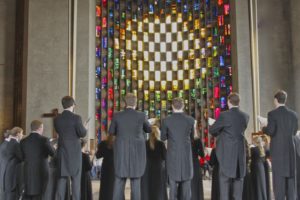By Christopher Kimpston
Major: BA in Music/Religion
Like much of England that we have seen so far, Coventry is an amalgamation of new and old. New concrete is poured next to ancient stones, and the lines of holy ground and modern convenience stores twist around each other to make up this beautiful country. Coventry provided the ultimate example of this blend of the updated and the timeless.
Coventry University sits across from the cathedral, proudly displaying its ranking as the “Modern University of the Year” on a sign by the sidewalk. A couple of blocks away, a modern shopping complex sits next to a statue of historic Lady Godiva, immortalized for her kindness to a past generation of Coventry residents. Even the cathedral itself, acknowledged for both its post-WWII rebuilding and untouched ruins, stands as a gorgeous example of a modern country in love with its long history. It was the heart of this building’s convictions, however, that made singing here an unforgettable experience.
Coventry, we learned, is known for its industry. Because of this practical importance, during World War II, the Nazis attacked the city of Coventry with 11 continuous hours of firebombing. The medieval cathedral found itself ablaze amidst these attacks, and most of the ancient structure was destroyed. With both its Cathedral and over 50,000 homes destroyed, the city of Coventry had to rebuild. They would have to account for hundreds of years of lost history in the form of architecture, homes, and personal belongings, and they would have to do it without the family and friends who had been killed in the attack. But first, they did something remarkable.
With pieces of the old church still smoldering, the Cathedral Canon wrote, in chalk, the words “Father, forgive” on the remaining wall behind the altar. The community then prayed for the Nazis, forgiving them for what they had done the previous day. Since then, the church has focused its ministry on the idea of reconciliation, and holds daily prayers for reparative work to be done for all people across the world.
Upon entrance, the new cathedral is quite obviously unlike any other. Behind the alter is a tapestry that stands over 70 feet tall and 30 feet wide, depicting Jesus Christ surrounded by the figures and symbols of the writers of the Gospels. The art is of a much more modern style than any other art we’ve witnessed on this trip, and its sheer size makes it an immediate focus to the eye. The stained glass of the cathedral is hidden to those entering, but when you reach the front and look backwards, however, the diagonal walls give the impression that the walls themselves are made of multicolored light. This position also gives view through the glass back wall, making visible the ruins of the old church. The baptismal fount is carved out of a boulder from Bethlehem, which was delivered by individuals of many faiths, Christian and non-Christians alike, working together to bring the large rock to this specific resting place. The entire facility drips with symbolism, and there was intention behind every facet of construction. The culmination of all of these aspects is the cross over the altar, which is a work of modern art that has two nails tied together in the form of the cross of Jesus’ crucifixion. Surrounding the cross is a figure that represents a phoenix, the mythical bird that is born again out of the ashes. This bird has become a symbol of the city, which has indeed risen out of the ashes of these terrible acts of violence.
As we continue to travel across England, we continue to learn about how residents in a different country go about their lives. In comparison to our customs, there are quirky differences (their McDonald’s drink sizes are much smaller), and more substantive ones (their society functions on a much older foundation of both physical and governmental structures), but there are things that we all can learn on this tour. If we take anything with us back to the United States, however, I hope that it is this message of forgiveness in the face of oppression, patience in the face of frustration, and love in the face of hatred that we saw so embodied in every facet of Coventry Cathedral.
I can speak for other members of Chamber Choir when I say that I will never forget performing “Coventry Carol,” which is a scriptural narration of King Herod’s slaying of innocent children. It is a moving and humbling process that puts your own problems in perspective. I am still processing the magnitude of emotions felt by our performance in Coventry, and will continue to process them for a while. What we experienced here was something that transcends our individual situations, links us to the past, and gives us hope for a forgiving, loving future.






















